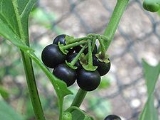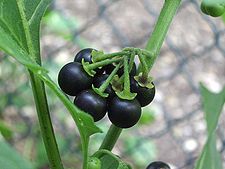
Solanum nigrum
Encyclopedia
Solanum nigrum is a species in the Solanum
genus, native to Eurasia
and introduced in the Americas
, Australasia
and South Africa
.
1–3 cm (1/2-1") long with a winged upper portion. The flowers have petals greenish to whitish, recurved when aged and surround prominent bright yellow anthers. The berry is mostly 6–8 mm (1/4-3/4") diam., dull black or purple-black. In India, another strain is found with berries that turn red when ripe.
Sometimes Solanum nigrum is confused for deadly nightshade
, a different Solanaceae
species altogether.

, the berries are casually grown and eaten; but not cultivated for commercial use. The berries are referred to as "fragrant tomato." Although not very popular across much of its growing region, the fruit and dish are common in Northern Tamil Nadu, Southern Andhra and Southern Karnataka. In North India, the boiled extracts of leaves and berries are also used to alleviate the patient's discomfort in liver-related ailments, including jaundice.
In Ethiopia
, the ripe berries are picked and eaten by children in normal times, while during famines all affected people would eat berries. In addition the leaves are collected by women and children, who cook the leaves in salty water and consumed like any other vegetable. Farmers in the Konso Special Woreda
report that because S. nigrum matures before the maize is ready for harvesting, it is used as a food source until their crops are ready. The Welayta people
in the nearby Wolayita Zone
do not weed out S. nigrum that appear in their gardens since they likewise cook and eat the leaves.
In South Africa
, the very ripe and hand-selected fruit (nastergal in Afrikaans
and umsobo in Zulu
) is cooked into a beautiful but quite runny purple jam.
In Greece
the leaves are one of the ingredients included in the salad of boiled greens
known as horta.
In Indonesia, the young fruit is eaten raw as part of a traditional salad 'lalapan' or cooked with oncom and chillies.
.
This plant is also known as Peddakasha pandla koora in Telangana region.
This plant's leaves are used to treat mouth ulcers that happen during winter periods of Tamil Nadu, India. Chinese experiments confirm that the plant inhibits growth of cervical carcinoma (Fitoterapia, 79, 2008, № 7-8, 548-556).
 S. nigrum is a widely used plant in oriental medicine. It is is antitumorigenic, antioxidant
S. nigrum is a widely used plant in oriental medicine. It is is antitumorigenic, antioxidant
, anti-inflammatory, hepatoprotective, diuretic
, and antipyretic
.
Solanum
Solanum, the nightshades, horsenettles and relatives, is a large and diverse genus of annual and perennial plants. They grow as forbs, vines, subshrubs, shrubs, and small trees, and often have attractive fruit and flowers. Many formerly independent genera like Lycopersicon or Cyphomandra are...
genus, native to Eurasia
Eurasia
Eurasia is a continent or supercontinent comprising the traditional continents of Europe and Asia ; covering about 52,990,000 km2 or about 10.6% of the Earth's surface located primarily in the eastern and northern hemispheres...
and introduced in the Americas
Americas
The Americas, or America , are lands in the Western hemisphere, also known as the New World. In English, the plural form the Americas is often used to refer to the landmasses of North America and South America with their associated islands and regions, while the singular form America is primarily...
, Australasia
Australasia
Australasia is a region of Oceania comprising Australia, New Zealand, the island of New Guinea, and neighbouring islands in the Pacific Ocean. The term was coined by Charles de Brosses in Histoire des navigations aux terres australes...
and South Africa
South Africa
The Republic of South Africa is a country in southern Africa. Located at the southern tip of Africa, it is divided into nine provinces, with of coastline on the Atlantic and Indian oceans...
.
Description
Black nightshade is a fairly common herb or short-lived perennial shrub, found in many wooded areas, as well as disturbed habitats. It has a height of 30–120 cm (12-48"), leaves 4-7.5 cm (1 1/2-3") long) and 2–5 cm wide (1-2 1/2"); ovate to heart-shaped, with wavy or large-toothed edges; both surfaces hairy or hairless; petiolePetiole (botany)
In botany, the petiole is the stalk attaching the leaf blade to the stem. The petiole usually has the same internal structure as the stem. Outgrowths appearing on each side of the petiole are called stipules. Leaves lacking a petiole are called sessile, or clasping when they partly surround the...
1–3 cm (1/2-1") long with a winged upper portion. The flowers have petals greenish to whitish, recurved when aged and surround prominent bright yellow anthers. The berry is mostly 6–8 mm (1/4-3/4") diam., dull black or purple-black. In India, another strain is found with berries that turn red when ripe.
Sometimes Solanum nigrum is confused for deadly nightshade
Deadly nightshade
Atropa belladonna or Atropa bella-donna, commonly known as Belladonna, Devil's Berries, Death Cherries or Deadly Nightshade, is a perennial herbaceous plant in the family Solanaceae, native to Europe, North Africa, and Western Asia. The foliage and berries are extremely toxic, containing tropane...
, a different Solanaceae
Solanaceae
Solanaceae are a family of flowering plants that include a number of important agricultural crops as well as many toxic plants. The name of the family comes from the Latin Solanum "the nightshade plant", but the further etymology of that word is unclear...
species altogether.

Culinary usage
In IndiaIndia
India , officially the Republic of India , is a country in South Asia. It is the seventh-largest country by geographical area, the second-most populous country with over 1.2 billion people, and the most populous democracy in the world...
, the berries are casually grown and eaten; but not cultivated for commercial use. The berries are referred to as "fragrant tomato." Although not very popular across much of its growing region, the fruit and dish are common in Northern Tamil Nadu, Southern Andhra and Southern Karnataka. In North India, the boiled extracts of leaves and berries are also used to alleviate the patient's discomfort in liver-related ailments, including jaundice.
In Ethiopia
Ethiopia
Ethiopia , officially known as the Federal Democratic Republic of Ethiopia, is a country located in the Horn of Africa. It is the second-most populous nation in Africa, with over 82 million inhabitants, and the tenth-largest by area, occupying 1,100,000 km2...
, the ripe berries are picked and eaten by children in normal times, while during famines all affected people would eat berries. In addition the leaves are collected by women and children, who cook the leaves in salty water and consumed like any other vegetable. Farmers in the Konso Special Woreda
Konso special woreda
Konso is one of the 77 woredas in the Southern Nations, Nationalities, and Peoples Region of Ethiopia. Because Konso is not part of any Zone in the SNNPR, it is considered a Special woreda, an administrative subdivision which is similar to an autonomous area. This woreda is named after the Konso...
report that because S. nigrum matures before the maize is ready for harvesting, it is used as a food source until their crops are ready. The Welayta people
Welayta people
Wolayta is the name of an ethnic group and its former kingdom, located in southern Ethiopia. According to the most recent census , they number 1.7 million people or 2.31 percent of the country's population, of whom 289,707 are urban inhabitants...
in the nearby Wolayita Zone
Wolayita Zone
Wolayita is a Zone in the Ethiopian Southern Nations, Nationalities and Peoples Region . it is named for the Welayta people, whose homeland lies in this Zone...
do not weed out S. nigrum that appear in their gardens since they likewise cook and eat the leaves.
In South Africa
South Africa
The Republic of South Africa is a country in southern Africa. Located at the southern tip of Africa, it is divided into nine provinces, with of coastline on the Atlantic and Indian oceans...
, the very ripe and hand-selected fruit (nastergal in Afrikaans
Afrikaans
Afrikaans is a West Germanic language, spoken natively in South Africa and Namibia. It is a daughter language of Dutch, originating in its 17th century dialects, collectively referred to as Cape Dutch .Afrikaans is a daughter language of Dutch; see , , , , , .Afrikaans was historically called Cape...
and umsobo in Zulu
Zulu language
Zulu is the language of the Zulu people with about 10 million speakers, the vast majority of whom live in South Africa. Zulu is the most widely spoken home language in South Africa as well as being understood by over 50% of the population...
) is cooked into a beautiful but quite runny purple jam.
In Greece
Greece
Greece , officially the Hellenic Republic , and historically Hellas or the Republic of Greece in English, is a country in southeastern Europe....
the leaves are one of the ingredients included in the salad of boiled greens
Boiled greens
Boiled greens are leaves cooked for food. They are part of many cuisines, and may be the leaves of common cultivated vegetables, such as spinach, fennel, mustard, or turnip, or the leaves of wild plants such as dandelion, wild radish, and purple amaranth....
known as horta.
In Indonesia, the young fruit is eaten raw as part of a traditional salad 'lalapan' or cooked with oncom and chillies.
Medicinal usage
The plant has a long history of medicinal usage, dating back to ancient GreeceGreece
Greece , officially the Hellenic Republic , and historically Hellas or the Republic of Greece in English, is a country in southeastern Europe....
.
This plant is also known as Peddakasha pandla koora in Telangana region.
This plant's leaves are used to treat mouth ulcers that happen during winter periods of Tamil Nadu, India. Chinese experiments confirm that the plant inhibits growth of cervical carcinoma (Fitoterapia, 79, 2008, № 7-8, 548-556).

Antioxidant
An antioxidant is a molecule capable of inhibiting the oxidation of other molecules. Oxidation is a chemical reaction that transfers electrons or hydrogen from a substance to an oxidizing agent. Oxidation reactions can produce free radicals. In turn, these radicals can start chain reactions. When...
, anti-inflammatory, hepatoprotective, diuretic
Diuretic
A diuretic provides a means of forced diuresis which elevates the rate of urination. There are several categories of diuretics. All diuretics increase the excretion of water from bodies, although each class does so in a distinct way.- Medical uses :...
, and antipyretic
Antipyretic
Antipyretics ; an-tee-pahy-ret-iks; from the Greek anti, against, and pyreticus, are drugs or herbs that reduce fever. Normally, they will not lower body temperature if one does not have a fever. Antipyretics cause the hypothalamus to override an interleukin-induced increase in temperature...
.

